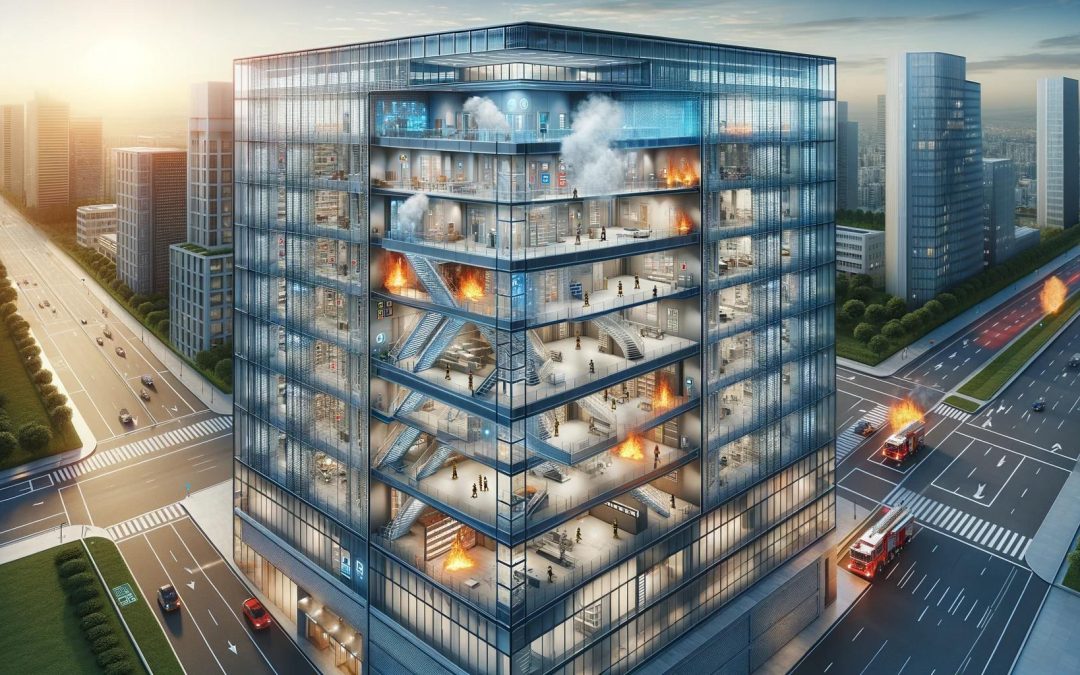High-rise buildings present special challenges in terms of fire safety. In such structures, smoke poses a serious threat because it can spread quickly, reducing visibility, damaging property and endangering the health of residents. One effective way to manage this problem is to implement smoke control systems. This blog post will explore the importance of these systems and their impact on improving fire safety in high-rise buildings, looking at how effective smoke control can significantly reduce the risk and impact of fires in high-rise buildings.
Spis treści:
Smoke Control Systems
Smoke control systems are designed to manage and control the flow of smoke in a building during a fire. Their key function is to limit the spread of smoke, which facilitates the evacuation of people and supports firefighting activities. These systems are mainly based on a combination of techniques such as smoke splitting, diluting and pressurizing to achieve this goal effectively.
Our company offers high-quality fire protection solutions. We encourage you to contact us: Tel/fax.: +48 (32) 236 30 05 or learn more about the details of our smoke vents: https://www.gulajski.pl/klapy-dymowe/
Key Components of Smoke Control Systems
Fire barriers
Fire barriers are used to divide a building into separate sections to prevent the spread of smoke. Made of fire-resistant materials, they are usually integrated into the structure of walls, floors and ceilings, creating effective protection against the rapid spread of smoke in the event of a fire.
Smoke vents
Smoke vents are designed to allow smoke and heat to escape from a building, most often through its roof. They can be controlled manually or automatically, equipped with sensors that activate in response to the detection of heat or smoke coming from a fire. Their role in the smoke control system is crucial, as they contribute to reducing the intensity and effects of a fire.
Pressure Systems
Pressurization systems are designed to create high-pressure areas in strategic areas of the building, such as stairwells and escape routes. Their main purpose is to prevent smoke from penetrating these zones, which is crucial for safety. With this system, these areas remain safe and smoke-free, allowing the building’s occupants to be safely evacuated in the event of a fire.
The role of smoke control systems in high-rise buildings
Smoke control systems are extremely essential in high-rise buildings for several key reasons:
Evacuation Assistance
In high-rise buildings with complex layouts, the evacuation process can be extremely challenging. Smoke control systems, by inhibiting the spread of smoke, provide clearer and safer escape routes. This gives residents more time to evacuate, which increases their chances of safely leaving the building in the event of a fire emergency.

Support in firefighting operations
Smoke control systems, by regulating the flow of smoke and heat, create safer conditions for emergency services during firefighting operations. They provide better visibility inside the building, which is crucial for firefighters when navigating and locating sources of fire. In addition, effective smoke control reduces the risk of flashover, which can occur in heavily smoked areas.
Property protection and damage minimization
Smoke control systems play a vital role not only in saving lives, but also in protecting property from damage. By limiting the spread of smoke and heat, these systems effectively reduce the extent of smoke and heat damage, especially in parts of the building that have not been directly affected by the fire. This means that unaffected areas can remain in better condition, reducing the overall cost of repairs and reconstruction after a fire.
See our offer for staircase smoke extraction systems: https://www.gulajski.pl/systemy-oddymiania-klatek-schodowych/ We also encourage you to contact our fire protection system engineers: Tel/fax.: +48 (32) 236 30 05 . We will help, advise and install. For architects, we have ready-made designs of fire protection systems.
Summary
Smoke control systems play an extremely important role in increasing fire safety in high-rise buildings. Effective smoke management by these systems is critical to safer evacuation, support rescue operations, and reduce property damage. As our cities develop more and more vertically, the importance of these systems in urban space becomes more and more important. It is therefore essential that we continue to innovate and refine these systems, ensuring that our skyscrapers are as safe as they impress with their size and architecture.
Autor: Tomasz Matuszek; Dział Marketingu - Firma Gulajski

